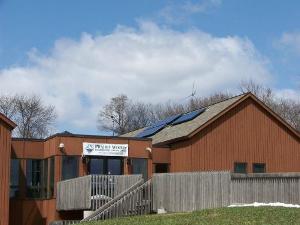Dec 30 2010
The Minnesota Department of Natural Resources (DNR) has awarded an amount of $1 million to 22 solar projects. These projects would be lighting parking lots, buildings, parks and trails, heat water for camping ground showers, power a drinking water well and electrify a trash compactor in parks and nature centers set up in the metro.
The Grants would be funded from a fraction of the sales tax money from the clean water, land and legacy amendment, which was passed in the year 2008. The money was to be used for clean water, wildlife habitat, trails, parks, cultural and art projects. An amount of $485,000 and $584,000 were allotted for solar projects in 2009 and 2010 respectively in parks and trails in the region or state. Around $35 million to $40 million would go to acquire and improve these recreation areas. Each of the 22 projects had to submit applications, meet the eligibility criteria and also provide with a 25% of equivalent funds.
 Prairie Woods Environmental Learning Center now uses solar panels and a wind generator and burns biomass. It’s a showplace for renewable energy on a home or small-business scale.
Prairie Woods Environmental Learning Center now uses solar panels and a wind generator and burns biomass. It’s a showplace for renewable energy on a home or small-business scale.
34 Solar panels would be installed in the Kroening Interpretive Center at Minneapolis’ North Mississippi Park. They would be mounted on a south-facing roof and produce around 28% of the total electricity consumption. They would also incorporate a touch screen kiosk, which would demonstrate the total energy produced by the solar panels and display other educational data. According to Eric Rehm, Planning Project Manager of the Minneapolis Parks, this project would not only educate the people about solar but it would also contribute to energy savings and environmental benefits. The money saved from the utility bills could be used more productively for the development of the park. He further mentioned that the panels would be installed the next year in the spring, saving the center $1,330 every year in utility bills. The total investment would be $61,670 and the grant would pay $46,000.
The Como Park Pool in St. Paul would receive $150,000 for the installation of a solar thermal water heater for its bathhouse and concessions structure, and it would be a part of the $7 million swimming pool replacement for the park. Don Gange, St Paul Parks and Recreation’s Project Manager stated that the new system provided all the hot water being used for showers and sinks. He also mentioned that in 2012 the new pool complex would be built at the same place where the old pool was located.
John Barten, Three Rivers Park District’s Director of Natural Resources Management revealed that an amount of $144,000 from the legacy funds would be used to build a $350,000 solar electric system in the Richardson Nature Center in Bloomington. The solar panels would produce around half of the electricity requirements of the Center. He also mentioned that many people were not aware that Minnesota was a good state for solar as it was a sunny place.
Ten solar electric trash compactors would be installed in Duluth and ten recycling trash units would be installed all along its Lakewalk Trail using $40,000 from the funds. An amount of $60,000 would be given to Northland Arboretum located near Brainerd, which would be used for installing and connecting a solar array. This array would generate electricity for all the trail lighting, indoor and outdoor areas in the main community education building. According to Andrew Korsberg, the trail program coordinator for DNR, the grant program has demonstrated that there was no end to the variety of interesting solar projects. One stipulation from the DNR was that all the projects would display educational information about solar power for the benefit of the public. The Prarie Woods Environmental Learning Center, located 11 miles to the north of Willmar would install a solar electric system along with other equipments. The center was already the proud owner of solar panels and a wind power generator and also a biomass unit for producing electricity from sunflower seed hulls, crop residue and wood pellets. According to Dave Pederson, the Executive Director of the center, the new solar panels would make the center powered entirely by renewable energy sources.